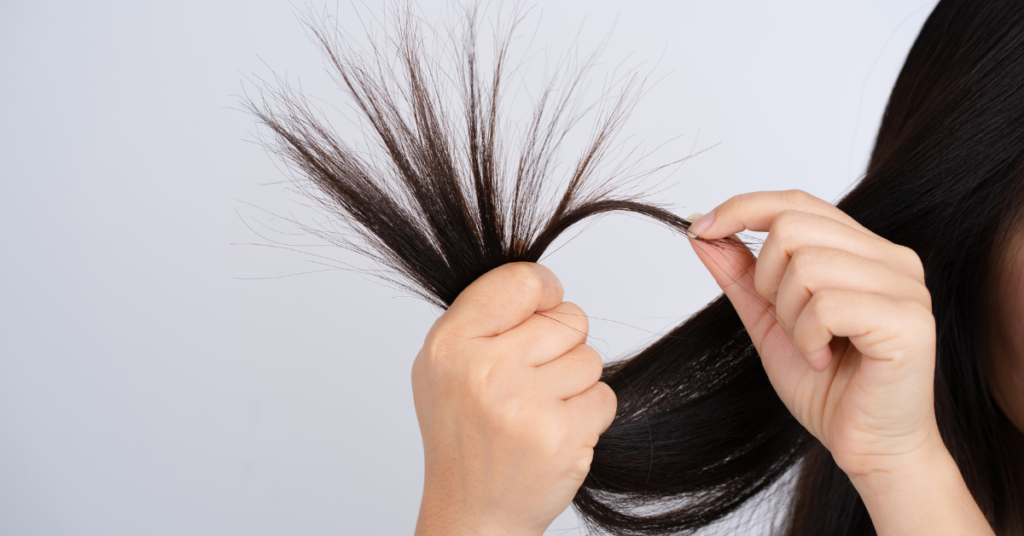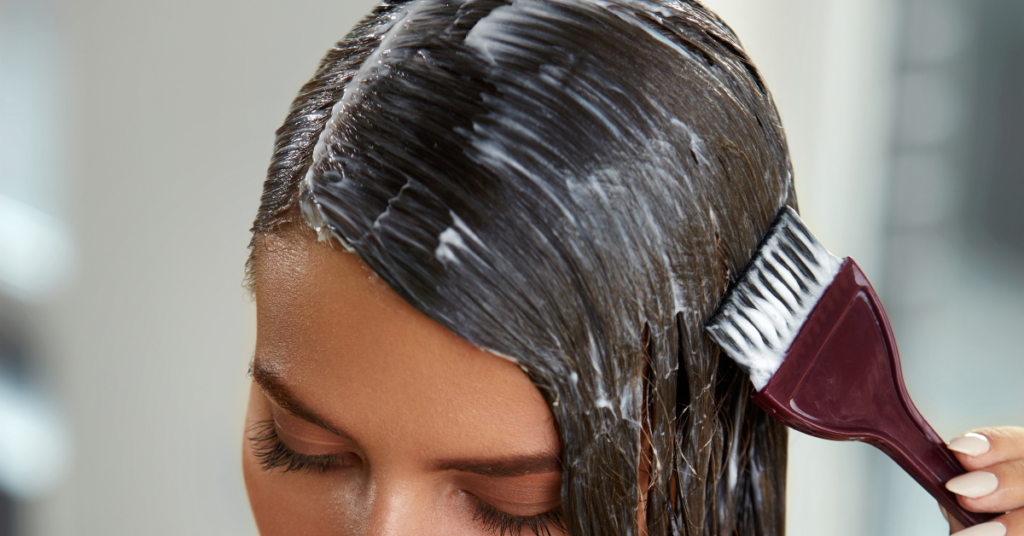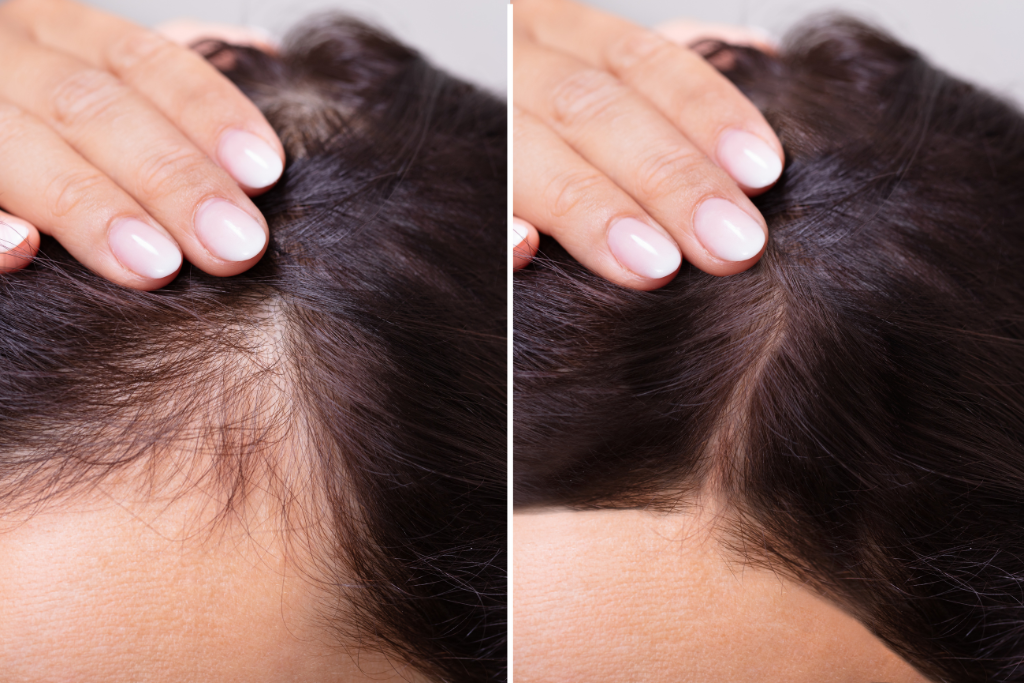Split ends are more than just a nuisance; they’re a cry for help from your hair. Every strand telling a story of stress, damage, and the need for care. In this exploration of split ends, we will delve into the heart of what causes these unwelcome hair splits and how they affect the overall health and appearance of your hair. From the well-known culprits like heat styling and chemical treatments to the more surprising factors, we’ll uncover the myriad reasons behind split ends.

Understanding Split Ends
What exactly are split ends? Technically known as trichoptilosis, split ends occur when the protective outer layer of the hair cuticle wears away due to external stressors and internal weaknesses. The result is the fraying or splitting of the hair fiber, usually at the tip, leading to weakened strands and an often frizzy appearance.
The Formation of Split Ends
Split ends don’t just appear overnight. They are the culmination of cumulative damage over time. Factors such as excessive heat styling, harsh chemical treatments, and even daily hair brushing contribute to the gradual deterioration of the hair’s integrity. Even the most well-intentioned hair care routines can unintentionally contribute to this problem. Products like Oribe Split End Seal and Dove Shampoo for Split Ends are specifically designed to address these issues, providing the hair with the necessary nutrients and protection to resist splitting.
Different Types of Split Ends
It’s not just the classic ‘Y’ shaped split end we need to worry about. Hair can split in multiple ways – from the basic bifurcation to deep, tree-like splits. Each type indicates a different level and type of damage. This is where targeted treatments like Mielle Rice Water Split End Therapy and Kerastase Split End Serum come into play, offering tailored solutions to different degrees of split end damage.
Understanding the nature of split ends is the first step in combating them. With a clear idea of what causes these hair woes, we can begin to explore the common culprits behind them and how to effectively prevent and treat them. In the next section, we will delve into the various causes of split ends, offering insight into how everyday activities and environmental factors play a significant role in hair health.
Common Causes of Split Ends

Understanding the causes of split ends is crucial in preventing and treating them effectively. While some factors are well-known, others might surprise you.
- Environmental Stressors: Just like our skin, our hair is vulnerable to environmental elements. Sun exposure, wind, and even dry air can sap the moisture from hair, leading to brittle strands prone to splitting. The use of protective products, such as leave-in conditioners and serums like the Virtue Split End Serum, can provide a shield against these elements.
- Chemical Treatments and Heat Styling: Regular use of hair dyes, bleaches, and heat tools like straighteners and curling irons is one of the most common causes of split ends. These processes break down the hair’s keratin, weakening it and making it more susceptible to splitting. Incorporating restorative treatments, like the Brazilian Blowout Split End Treatment or Olaplex products, can help mitigate this damage.
- Mechanical Stress: Surprisingly, everyday activities like brushing, towel drying, and even tying your hair too tightly can cause mechanical stress leading to split ends. Gentle hair care practices, combined with strengthening products such as Bed Head Leave-In Conditioner, can significantly reduce this type of damage.
- Nutritional Deficiencies: Just like the rest of the body, hair health is deeply connected to nutrition. Lack of certain vitamins and minerals can lead to weaker hair strands. Ensuring a balanced diet, supplemented with hair-focused nutrients, can improve overall hair health.
- Over-Washing and Improper Hair Care: Over-washing can strip hair of its natural oils, leading to dryness and fragility. Similarly, using harsh shampoos or skipping conditioner can exacerbate hair damage. Opting for gentle, nourishing shampoos and conditioners, such as Dove’s Shampoo for Split Ends, can help maintain hair’s natural balance.
Each of these factors contributes to the weakening of the hair fiber, eventually leading to split ends. By understanding these causes, we can take proactive steps to protect our hair. In the next section, we will explore effective prevention tips and care routines to keep split ends at bay.
Prevention and Care

Preventing split ends is more effective and less frustrating than trying to repair them after they occur. Here are some key strategies and products that can help in preventing split ends:
- Regular Trims: Perhaps the most straightforward method to prevent split ends is regular hair trimming. Keeping a schedule for trims (every 6-8 weeks) can help in managing and preventing the occurrence of split ends.
- Gentle Styling: Avoid excessive brushing and harsh styling techniques. When detangling, use a wide-toothed comb and start from the ends, working your way up. Additionally, reduce the frequency and temperature of heat styling tools to minimize damage.
- Use of Heat Protectant Products: Before using any heat styling tools, always apply a heat protectant. Products like the Split Ender Mini and Talavera Split Ender Pro2 offer not just protection but also help in maintaining the health of the hair ends.
- Deep Conditioning Treatments: Regular deep conditioning can help in maintaining the moisture balance of the hair. Products like the Living Proof Split End Mender or Pureology Strength Cure Split End Salve provide intensive care and hydration, helping to strengthen hair and prevent split ends.
- Healthy Diet and Hydration: Never underestimate the power of a healthy diet and adequate hydration in maintaining hair health. Foods rich in vitamins, minerals, and proteins play a crucial role in keeping hair strong and resilient.
- Avoiding Chemical Treatments: Minimizing the use of harsh chemical treatments like coloring and perming can significantly reduce the risk of developing split ends. If you do opt for these treatments, ensure proper aftercare with products like the Dove Split End Rescue Shampoo or the Virtue Labs Split End Serum.
- Proper Drying Techniques: Instead of rubbing your hair with a towel, gently pat it dry to avoid causing friction and frizz, which can lead to split ends.
By incorporating these preventive measures and care routines into your daily life, you can significantly reduce the likelihood of developing split ends. In the following section, we will explore various effective methods and products for repairing split ends, for those times when prevention isn’t enough.
Repairing Split Ends
Once split ends occur, the focus shifts to repair and mitigation. While completely fixing split ends is not possible without trimming, there are ways to improve the appearance and health of your hair.
- Split End Specific Treatments: Products like the Mielle Split End Therapy and Kerastase Split End Serum are specifically formulated to temporarily seal split ends, making hair appear smoother and healthier. These treatments can provide a stopgap solution until your next trim.
- Serums and Oils: Hair serums and oils can be effective in smoothing frayed ends and adding moisture. Virtue Split End Serum, for instance, is designed to nourish and repair the hair, giving it a healthier look.
- Leave-In Conditioners: A good leave-in conditioner, like the Bed Head Leave-In Conditioner, can make a significant difference. These products help in detangling, reducing breakage, and keeping the hair hydrated, which is essential for preventing further split ends.
- Bond-Building Treatments: Treatments like Olaplex are known for their ability to repair the hair’s disulfide bonds, which are often damaged in split ends. These treatments can help in restoring the hair’s strength and resilience.
- Professional Salon Treatments: Options like the Brazilian Blowout Split End Treatment offer a more intensive approach. These salon treatments can temporarily mend split ends and improve the overall health and appearance of your hair.
- Gentle Hair Care Practices: Continuing with gentle hair care practices is crucial. Avoid excessive brushing, and when detangling, be as gentle as possible to prevent further damage.

While these treatments and practices can help in managing split ends, it’s important to remember that the only true remedy for split ends is trimming them off. However, these methods can significantly improve the appearance and health of your hair in between trims. In the next section, we’ll guide you on how to choose the right products for your specific hair type and split end needs.
Choosing the Right Products
Selecting the right products is key in dealing with split ends effectively. Here are some tips for choosing products that will work best for your hair type and specific needs:
- Understand Your Hair Type: Different hair types require different care. Fine hair might benefit from lightweight serums like Virtue Serum, while thicker or coarser hair might need more intensive treatments like the Kerastase Split Ends Serum.
- Look for Nourishing Ingredients: Ingredients like argan oil, keratin, and biotin are known for their hair-strengthening properties. Products like Moroccanoil Mending Infusion and Mielle Rice Water Split End Therapy contain such beneficial ingredients.
- Avoid Harsh Chemicals: Try to use products free from sulfates, parabens, and alcohol, as these can further dry out and damage your hair. Opt for natural or gentle formulations like Dove Split End Rescue Shampoo or Pureology Strength Cure Split End Salve.
- Consult with a Professional: If you’re unsure about what products to use, consult with a hair care professional. They can provide personalized recommendations based on your hair’s condition and needs.
- Read Reviews and Do Research: Before purchasing, read reviews and research products. Look for products that have proven results and high satisfaction rates among users with similar hair concerns.
- Consider Multi-Functional Products: Some products, like Eva NYC Mane Magic 10-in-1 Split End Mender, offer multiple benefits in one, such as heat protection, hydration, and repair. These can be great time-savers and provide comprehensive care for your hair.
Remember, what works for one person might not work for another, so it may take some trial and error to find the perfect products for your hair. In our next section, we’ll explore advanced treatments and serums that offer specialized care for split ends.

Advanced Treatments and Serums
For those seeking more intensive care, advanced treatments and serums offer specialized solutions for split ends. Here’s a look at some options:
- Professional Salon Treatments: Salons offer a range of treatments specifically targeting split ends. Treatments like the Brazilian Blowout Split End Correction and Talavera Split Ender Pro provide professional-level care, helping to seal and protect hair ends.
- High-Performance Serums: Serums are a great way to provide concentrated care to your hair. Products like Virtue Serum and Kerastase Split Ends Serum are designed to penetrate deeply into the hair shaft, repairing and preventing further damage.
- Bond Builders: Bond-building treatments like Olaplex work at a molecular level to repair the disulfide bonds in hair that are broken during chemical processes and physical stress. These treatments are particularly effective for hair that has been chemically treated.
- Natural Oil Treatments: Natural oils like argan oil and coconut oil can be effective in nourishing and sealing split ends. These oils can be used as a pre-shampoo treatment or a leave-in conditioner to add moisture and shine.
- Rice Water Treatments: Inspired by traditional beauty rituals, products like Mielle Rice Water Split End Therapy utilize rice water’s natural benefits to strengthen and smooth hair.
- Customizable Hair Masks: Customizable hair masks allow you to target your specific hair needs, including split ends. Ingredients like honey, avocado, and egg can be added to enhance the mask’s nourishing and reparative properties.
When selecting advanced treatments and serums, consider your hair’s specific needs and any underlying issues like dryness or damage. These treatments can offer a significant boost to your hair care routine, providing targeted solutions for managing and repairing split ends.
Conclusion
Split ends are a common hair concern, but understanding their causes and knowing how to prevent and treat them can make a significant difference in your hair’s health and appearance. We’ve explored a range of factors that contribute to split ends, from environmental stressors to chemical treatments and daily hair care practices. The key takeaway is that hair health is a reflection of how we treat it, both externally and internally.

We’ve also delved into various solutions, from daily care routines like using Dove Shampoo for Split Ends, to specialized treatments like the Brazilian Blowout Split End Treatment and innovative products like the Split Ender Pro. The importance of choosing the right products for your specific hair type, such as Virtue Serum for fine hair or Kerastase Split End Serum for thicker textures, cannot be overstated.
Remember, the journey to healthier hair is a continuous one. Regular trims, gentle styling, and proper nutrition play a crucial role. Incorporating products that nourish and protect, like Moroccanoil Mending Infusion and Olaplex, will help you maintain the integrity of your hair.
Ultimately, preventing and treating split ends is about understanding your hair’s needs and responding with care and consideration. With the right approach and products, you can achieve and maintain beautiful, healthy hair, free from the frustration of split ends.
This concluding section wraps up the blog post, summarizing the main points discussed and reinforcing the importance of understanding and caring for one’s hair to prevent and manage split ends.
Final Words
As we conclude our journey through understanding and tackling the challenge of split ends, we invite you to take proactive steps towards healthier hair. Start by assessing your current hair care routine and identifying any practices that might contribute to split ends. Consider incorporating some of the products and treatments we’ve discussed, like the Split Ender Pro for trimming and the Moroccanoil Mending Infusion for nourishment.
Remember, the best treatment for split ends is prevention. Schedule regular trims, use protective styling products, and opt for gentle hair care practices. If you’re struggling with choosing the right products, don’t hesitate to consult with a hair care professional who can provide tailored advice based on your hair type and condition.
For those looking to delve deeper into hair health, explore products that have garnered positive reviews for treating split ends, such as the Virtue Split End Serum or Dove’s Split End Rescue Shampoo. Your journey to stronger, healthier hair is a personal one, and exploring different products and treatments will help you discover what works best for your unique hair needs.
We encourage you to share your experiences and successes in managing split ends. What products or practices have made a noticeable difference for you? Sharing your story can inspire and help others in their quest for healthier hair.
Let’s embrace the journey to healthier hair together, one strand at a time!



